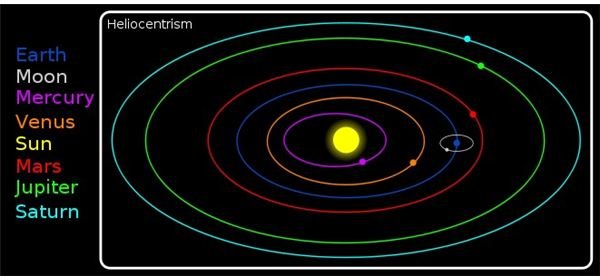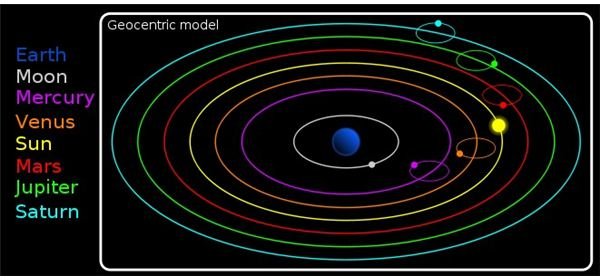Astronomy in the Classical, Medieval, and Renaissance Periods of History
Astronomy in the Classical Age
According to the astronomers of ancient Greece, the Earth was the center of the Universe. The Moon, Sun, stars, and five known planets - Mercury, Venus, Mars, Jupiter, and Saturn - revolved around the Earth in great big circles. This view of the Universe is called a “geocentric cosmology.”
To the ancient Greeks in a time when telescopes had not yet been invented, the planets were pinpoints of light that looked like the other stars. However, unlike the stars, they changed position from night to night, usually eastward compared to the background stars. The word “planet” means “wandering star.”
The Greeks also saw that the planets didn’t always move in the same direction. Sometimes they would slow down, stop, and even move westward for a short time (weeks to months) before resuming their usual eastward direction. This backward movement is called “retrograde motion.”
To explain the motion of the planets, Greek astronomer Hipparchus proposed a system of epicycles, which are smaller circles that travel along an overall big circle called a deferent. A planet that had stopped moving forward was simply moving in the reverse direction of its epicycle. Ptolemy, one of the last great Greek astronomers, painstakingly worked out every last detail about these epicycles - how big they were, how fast the planets moved on them, how fast the epicycles moved on their deferents, how big the deferents were, and so on. He published his work in the 13-volume Almagest in about 150 CE, and it became the established cosmology for the next thousand years.
Some Astronomical History
By the middle of the medieval period in European history, minor discrepancies had accumulated to the point where Ptolemy’s epicycles no longer matched where the planets actually were. For a time, medieval astronomers tried to adjust by adding more epicycles, but the system was becoming more and more convoluted, and less and less useful.
The first astronomer to propose a heliocentric cosmology - one where the Sun was the center of the universe rather than the Earth - was Aristarchus of Samos around 300 BCE. At that point in history, known evidence about the Earth was against the theory and it received little attention. However, in medieval times, Polish astronomer Nicolaus Copernicus revisited the idea.
Copernican Heliocentrism

Copernicus had noticed that Mercury and Venus were always somewhere close by the Sun, while Mars, Jupiter, and Saturn could be seen in the middle of the night. This observation made sense from a heliocentric perspective with Earth as one of the planets, Mercury and Venus closer to the Sun than Earth, and Mars, Jupiter, and Saturn farther away. A heliocentric model would also largely eliminate the need for convoluted epicycles. Simple, straightforward circular orbits still didn’t fit quite right because the planets don’t move at a constant speed, however, so each planet still had a small epicycle.
Copernicus documented all the details of his cosmology in Revolutionibus Orbium Celestium (On the Revolution of the Celestial Spheres), published in 1543 and dedicated to Pope John Paul III. In medieval and early Renaissance times, it was heresy to say that the Earth was not the center of the Universe, that it was a planet, and that it moved. The book’s publisher presented the theory as an alternative mathematical model to Ptolemy’s for calculating the positions of the planets, with a careful note that just because it worked as such in computational astronomy, it didn’t necessarily have to be viewed as Truth or literal reality. This kept the Roman Catholic Church quiet for about 60 years.
Astronomy in the Renaissance
Most late Medieval and early Renaissance astronomers did not accept Copernican heliocentrism, as it was too radical a departure from the prevailing Ptolemaic cosmology. One of them, Tycho Brahe, reasoned that if the Earth really did revolve around the Sun, the stars should shift position back and forth in the skies with each revolution - a phenomenon called “parallax.” Tycho took massive quantities of extremely precise notes on the positions of hundreds of stars over many years in order to look for it. Since he didn’t see any, and it was unfathomable that the stars could be so far away that naked-eye observations wouldn’t be able to detect it, he concluded that Copernican heliocentrism must be wrong. He suggested a compromise model where the planets orbit the Sun, and the Sun, Moon, and stars orbit the Earth. The Tychonic system was well-received by many Renaissance astronomers.
Galileo and Kepler
On the Copernican side of the debate was Galileo Galilei, an Italian astronomer who was the first to point a telescope up at the heavens. Among other things, he saw that the Moon was not a perfect sphere after all but had mountains and craters, and that the Sun had sunspots. He saw that Venus had phases, and that she was much larger in crescent phase than gibbous - an impossibility under geocentrism. Most famously, he discovered four moons that clearly orbited Jupiter instead of Earth. He published his findings in Sidereus Nuncius (Starry Messenger) in 1610.

Since his observations directly contradicted Biblical scripture in multiple places, in 1616 the Roman Catholic Church ordered Galileo to stop defending it, working on it, or teaching it. Then in 1632, after he published Dialogue Concerning the Two Chief World Systems which clearly sided with heliocentrism over geocentrism, the Inquisition placed him under house arrest for the rest of his life for heresy and banned all of his books.
Meanwhile, farther north in central Europe, it had occurred to Johannes Kepler that planetary orbits didn’t have to be circular. Past astronomers - classical and medieval - had all assumed that God, who lives in the heavens with the stars and planets, would only use the most perfect and harmonious geometric shape to control the movement of the planets. Working from Tycho’s notes that he inherited after Tycho’s death, Kepler tried ovals for a number of years before discovering that the orbital paths made perfect sense with ellipses. Suddenly there was no more need for epicycles at all. More importantly, his work on the problem caused him to formulate his three famous laws - published in 1609 and 1619 - that laid much of the groundwork for modern astronomy and physics.
References and Image Credits
Kaufman, W.J. III. Universe 2nd ed. W.H. Freeman and Company, 1987.
Geocentrism and Heliocentrism diagrams modified from Niko Lang, used under CC-A-SA 2.5 license.
Galilean Moons image from NASA.
